Can an astronaut throw a ball to the Earth? The answer is Yes, and No. Depends what you mean by hitting the Earth.
First, if you throw a ball towards the Earth - yes it's traveling that way when you throw it. So, it is natural to think that no matter how slow it is, it would get there eventually. However, we aren't used to throwing things in orbit, and our intuitions can often lead us astray.
This astronaut is throwing something out of the ISS. Can it hit the Earth?
Let's look at what happens half an orbit later (about 45 minutes later). The extra velocity you gave it with your throw is in the same direction as before, but because of the orbit, that direction now points away from the Earth and directly back towards the ISS.
So it doesn't keep going towards the Earth. Depending on where it is, roughly half the time it travels towards the Earth relative to the ISS and roughly half the time it travels away from the Earth. It crosses the orbit of the ISS roughly half an orbit after you throw it, and crosses it a second time, a full orbit later.
If the orbit of the ISS is perfectly circular, your ball's orbit will be more elliptical. It has a perigee - time when it's closest to the Earth a quarter of an orbit after you threw it, then returns across the orbit of the ISS half an orbit later, and has an apogee, furthest from Earth, three quarters of an orbit after you throw it.
LET'S TAKE AN EXAMPLE
Suppose the ISS is passing just south of Australia. If you throw a ball towards the Earth from the ISS you'd think it would fall into the Tasmanian sea. After all it is traveling towards the sea, so no matter how slowly it travels, surely it will get there eventually.
But of course, it is in orbit as well with an orbital speed of over seven kilometers per second, and your feeble throw has hardly changed its orbital speed at all. Half an orbit later (45 minutes for the ISS) then both the ISS and your ball will be traveling over the Atlantic just south of the UK.
For instance if you throw it ten meters per second towards the Tasmanian sea relative to the ISS right now, then forty five minutes later, it is still traveling 10 meters per second in that same direction relative to the ISS - but because you are on the opposite side of the Earth now, that direction now points out of the Atlantic back to the ISS.
You can check where the ISS is right now using ISS tracker. And then check where it is 45 minutes later. You should find it is above the opposite side of the world.
CAN YOU THROW IT AND CATCH IT AGAIN?
Now that we know it won't hit Earth, what about trying to catch it? Can we throw it in such a way that it comes back to our hand a bit like a boomerang?
Well, in theory you can. In practice, it's very hard.
First, you might, very naturally again, think it's going to return half an orbit later. After all you threw it towards the Earth and half an orbit later it's returning from the direction of the Earth.
However, that doesn't work, even in the most ideal situation, because by throwing it towards the Earth, you make it orbit closer to the Earth and so it goes around it faster (by Kepler's second law, of equal areas in equal times).
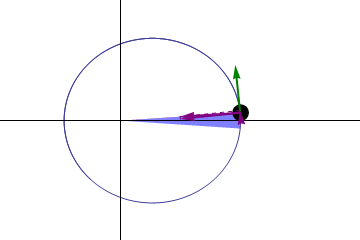
Kepler's second law of equal areas in equal times - an object in an elliptical orbit will go around the Earth faster when it is closer to the Earth, and slower when further away - so completes the part of its orbit closest to the Earth more quickly than the ISS. Image by Gonfer, wikipedia.
Yes, half an orbit later, it will cross the track of the ISS, but because it is faster than the ISS, it will be ahead of the ISS.
Another way to see it - this is less accurate because it doesn't take account of the changing pull of gravity depending on your distance from the Earth - but it gives a first rough approximation of how it works for small velocities. If you throw it towards the Earth, then a quarter of an orbit later, the direction of your throw, and so of the extra velocity, is in the same direction as the ISS itself is traveling. So it travels around the Earth slightly faster than the ISS in the first half of its orbit, and ends up ahead of you by the time it crosses the orbit of the ISS half an orbit later. If you threw it at a modest ten meters per second, it's still going to be many kilometers ahead of you by the time it gets back to the ISS orbit forty five minutes later.
Then for the second half of the orbit it is further away from the Earth than the ISS, and goes around the Earth more slowly than the ISS. (With the other approximate way of looking at it, the direction of your original throw is now backwards along the path of the ISS so it goes around the Earth slower than the ISS).
So, you'd see it travel away from you towards the Earth, swing around in a big arc in front of the ISS, then curve back a bit like a boomerang and one orbit later it would arrive back in your hand from the other side of the ISS from Earth.
However, that's all rather theoretical. To catch it like that, it has to have the same orbital period as the ISS, otherwise, when it completes its orbit, the ISS either hasn't got there yet, or has already gone past.
HOW TO GET IT TO RETURN TO YOUR HAND (IN THEORY)
Theoretically, the way to get it to return (from a circular orbit) is to throw it directly towards the Earth.
That raises its apogee (the point when it is furthest from the Earth) - but it lowers its perigee by exactly the same amount. So the major axis is unchanged (the longest diameter of its ellipse), so it has exactly the same orbital period as the ISS (by Kepler's third law, the orbital period depends on the length of the longest axis of the ellipse).
WHY IT IS LIKELY TO BE ALMOST IMPOSSIBLE TO GET IT TO RETURN TO YOUR HAND ON THE NEXT ORBIT
This is all of course assuming an ideal situation. In practice there are other complications that would need to be looked into.
First - the drag of the upper atmosphere is bound to be different which may affect the orbit - just because of its different shape and density.
Minor effects would include solar wind pressure and light pressure from the sun, which would be different as well of course.
Also the Earth's gravitational field is not perfectly spherical but has many anomalies in it, e.g. over continents and mountain ranges and ocean depths. So a ball that follows a slightly different trajectory from the ISS would be affected by those anomalies differently. So, in practice, the ISS orbit is not circular but a slightly irregular shape depending on the Earth's gravitational anomalies.
So even if you throw it precisely towards the Earth (or away from the Earth), which is already close to impossible - it will almost certainly end up in an orbit with a slightly different orbital period from the ISS.
Then as well as that, it has a different cross section to the ISS, and there's quite a lot of atmosphere there, so it would end up either falling towards the Earth either more quickly or more slowly than the ISS. So by the time it phases around so that it is back in phase it's either at a higher or a lower orbit. In practice, it would normally be in a lower orbit.
Another complication, the ISS changes its orbit slightly from time to time, sometimes to avoid orbital debris, also boosting in order to avoid falling back to the Earth because of the slight drag of the few atoms of our atmosphere at its altitude.
HOW TO GET IT TO MISS THE ISS
In practice, if astronauts throw anything out of the ISS, they don't want to catch it. Instead they will want it to miss the ISS, because they don't want things to hit it.
Throw it directly backwards from a circular orbit, and this will lower its perigee (closest point to Earth), and the apogee is unchanged, so this reduces the major axis and so it goes into a faster orbit.
Throw it directly forwards and this will raise its apogee, perigee is unchanged and it goes into a higher and slower orbit.
If you throw it sideways at an angle to the ISS orbit then it will go into an orbit with a slightly different inclination, reducing the chance of it ever reaching the ISS, because there are only two places in its orbit where it can hit the ISS. So even if it eventually phases back to the ISS, they will almost never be in the right places both at the same time, if they have different inclinations and slightly different orbital periods.
If you never want to see it again, it is better to put it into a lower and faster orbit, because that increases its orbital drag and means that eventually it will end up burning up in the atmosphere sooner. And a small body like that is also likely to have more orbital drag than the ISS as the ratio of surface area to mass goes up as the object gets smaller (even though much of the ISS is hollow and it has large solar panels).
So, if you want the best chance to miss the ISS then throw it a bit sideways and backwards along its orbit at a moderate speed.
It will be days probably before it gets back to the same position in its orbit as the ISS, and by then probably it already is in a lower orbit through drag effects especially if the ISS has done some boosts in between.
The ISS does major boosts once or twice a month
Plot of height of the ISS from Heavens Above - for the up to date plot see the website Height of the ISS
SOME OF THE THINGS THE ASTRONAUTS THROW OUT OF THE ISS AS EXPERIMENTS
They do actually throw things out of the ISS from time to time as scientific experiments. They choose the direction to throw it to make sure it won't come back and hit the ISS.
Here is a steel ball thrown out of the ISS to help test how well ground stations can track orbital debris
Also the rather dramatic "suitsat" using a discarded Russian spacesuit
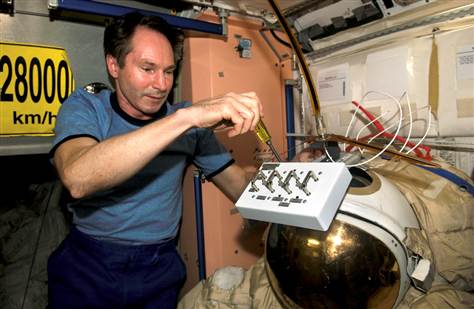
Cosmonaut Valery Tokarev preparing the old Russian Orlan spacesuit ready to throw it overboard the ISS as Suitsat".
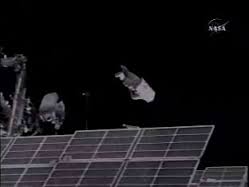
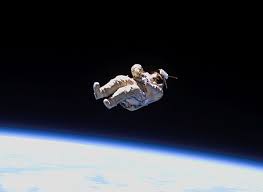
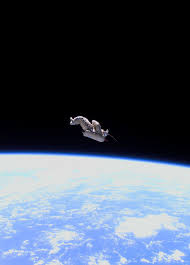
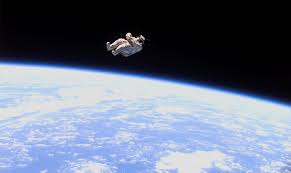
Suitsat spinning away from the ISS. You can watch it on NBC. They threw it backwards along its orbit, so that it would gradually get further and further behind the ISS - by the time it got back to the location of the ISS then drag would have pulled it down to a lower orbit because the lighter spacesuit would have more drag than the ISS.
And here is a video of Cosmonaut Oleg Artemyev throwing a Peruvian science nanosatellite into a separate orbit from the ISS.
Spacewalking Cosmonaut Tosses Tiny Satellite Into Space for Peru (Video)
And here are some images of it, from Beautiful Images of Astronauts Releasing Nanosatellites Into Space
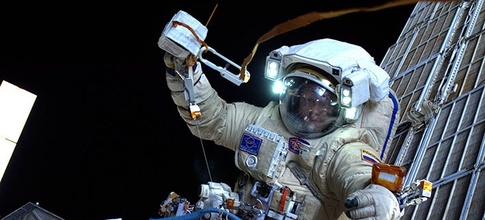
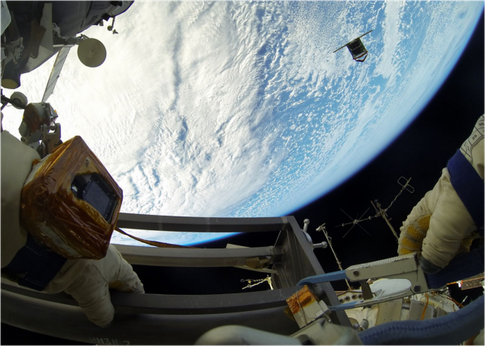
WHAT IF YOU WANT TO HIT THE EARTH
First if you are in no hurry, just note that at the height the ISS orbits, then your ball would eventually de-orbit through atmospheric drag. How fast this happens depends on its density, and the cross section it presents to the atmosphere, and is especially fast for small objects because of the high surface area to mass ratio.
So strictly speaking, yes, you can de-orbit a ball by hand. And it doesn't matter much how fast you throw it or what direction you throw it - if you don't mind waiting, eventually it will hit Earth. Suitsat 1 re-entered one month later. In the case of the Swiss satellite CubETH then it's expected to last four months in orbit because they've added 1.5 kg of lead to it to increase its density and done everything they can to make it heavier, so reducing the drag.
So, you can expect it to hit Earth a few months later, no matter what direction you throw it.
That's because the entire ISS is also de-orbiting as well. So it will de-orbit because it is no longer attached to the ISS and doesn't have its own separate rockets to keep boosting it to a higher orbit. The ISS, as a large heavy object takes years, even decades to de-orbit. But a small object will take much less time.
That's exactly what happened with the Peruvian nanosatellite, the steel ball, suitsat, and everything else thrown out of the ISS. So you can say, actually, that astronauts have already de-orbited satellites by throwing them out of the ISS :). It not only can be done, it has been done, by various astronauts including Oleg Artemyev!
On the other hand if you want it to go in a straight line towards the Earth, you'd need to throw it at very great speed, far faster than a hypervelocity rifle bullet. Also, counter intuitively, you'd need to throw it backwards along your orbit.
Throw it at 17,100 mph (7.644 km / sec) (so at about twenty two times the speed of sound on Earth), backwards along your orbit and you'll counteract the orbital velocity of the ISS. It will then just fall directly towards the Earth under acceleration due to gravity and hit its atmosphere a few minutes later.
When it hits the atmosphere, it will slow down to terminal velocity through air resistance. Which for a bullet is quite slow at least compared to orbital velocity. Even for a 1 kg cannonball, diameter about 6 cm, say, the terminal velocity is only about 140 mph. You can try your own figures in this online terminal velocity calculator. But after a few more minutes eventually it will hit the ground.
There are guns able to fire as fast as that, e.g. this one which can fire projectiles at over 7.5 kilometers per second
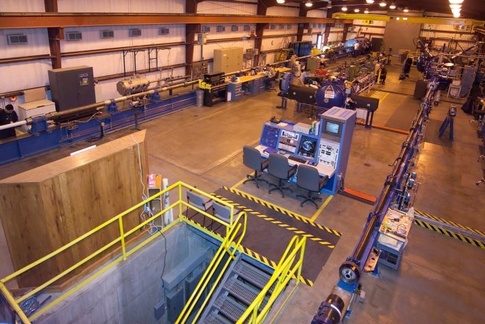
But I don't know if there are any outside of laboratories. Hypervelocity Impact Testing
You don't need to fire it quite as fast as that though. We don't need to hit the Earth directly. It is enough to get the bullet into an orbit that dips into the Earth's atmosphere low enough for re-entry like the Apollo astronauts or like shooting stars.
To do that - well the ISS at its highest is at 435 Km altitude. If we can get our bullet down to 70 km altitude it should re-enter.
So putting that into this orbit change calculator
then a velocity of 107 meters per second or about 0.1 km / second will do.
Many rifles can achieve this easily.
So - it seems that if you had a rifle on the ISS, you could do it. And actually the Russians do carry one with them for use in case they land in a remote place and need to scare off wild animals on return. It can also shoot distress flares. This is it.
The Russian Gun At The International Space Station - James Oberg's Pioneering SpaceIt has three barrels and is a combined shotgun, pistol, carbide and flare gun.
Every Soyuz has one - and the Soyuz remains docked to the ISS in case of an emergency return - so the gun is always available - though only intended for use on Earth.
Or at least, they used to. They later changed it to a regular semi-automatic pistol because of difficulty getting hold of ammunition for it. But even those can manage well over our 107 meters per second (or 351 fps).
So, it seems from this calculation - that if they fired bullets at the Earth, those bullets could achieve re-entry half an orbit later (just 45 minutes later) and create miniature shooting stars :).
Easy peasy indeed.
Again it is best to fire backwards along the orbit of the ISS to remove as much velocity as possible to get the perigee as close to the Earth as you can make it for maximum atmospheric drag. But with only 100 meters per second delta v required, you'd probably have plenty of margin to spare, so you wouldn't need to be especially careful how you aim it to achieve bullet re-entry.
What about throwing it by hand?
As for throwing it by hand, or using bows, etc, it's best to make things easier for our astronaut athletes. Using the Orbit injection calculator again, then at the lower altitude of 330 km, then a velocity of 77 meters per second will do.
The fastest baseball pitchers can pitch at over 100 mph or over 44 meters per second.
Fastest Pitcher in Baseball by Baseball Almanac
This is enough for the baseball to go into an orbit that dips down to 175 km if you threw it from the ISS at its lowest orbit of 330 km. That's not low enough for reentry. So I think safe enough to say that nobody will ever throw a ball from the ISS by hand, and manage to get it to re-enter the Earth's atmosphere just half an orbit later.
The fastest cricket ball ever thrown, according to the Guinness book of records, was thrown at 100.23 mph. So, that's similar to baseball - you couldn't hit the Earth's upper atmosphere in one go with a cricket ball.
The fastest tennis serve ever according to the Guinness book of records is 263 km / hour (163.4 mph). That's 73 meters per second. Still not enough, quite, though it is close.
A golfer could do it though. The fastest golf drive was 349.38 km / hour, or about 97 meters per second.
So, hit a golf ball from the ISS and you could give it enough delta v to re-enter the Earth's atmosphere half an orbit later, especially when the ISS is in its lower 330 km altitude orbit.
Well, that is, you could do it if you are an expert golfer, and can swing your golf club as easily as you can on Earth. With the current generation of spacesuits, I don't imagine the astronauts could do it, as they are rather stiff and cumbersome. They have to hold in the high pressure of the atmosphere, and it's said to be a bit like trying to work with your hands and fingers inside a garden hose.
What about bows?
Historical longbows only got up to around 170-180 fps (measured speed of 177 fps for one English longbow here). That's around 54 meters per second. It's not enough to hit the Earth half an orbit later, even when the ISS is in its lowest orbit of 330 km.
The fastest commercial longbows achieve 370 fps, so with these, you could manage it easily in the lower orbits, and could manage it, just, even when the ISS is at its highest altitude. Our 107 meters per second needed to hit the upper atmosphere from the ISS and achieve re-entry in half an orbit is a bit over 350 fps.
A crossbow is a little faster. The fastest commercial crossbows can fire a bolt at over 400 feet per second. That's 122 meters per second. It could hit the upper atmosphere from the ISS in half an orbit easily if aimed precisely. It would also be far easier to shoot - if pre-loaded, an astronaut in a spacesuit could probably manage it.
So, it seems a crossbow would work. Add a transponder to the bolt, and maybe you could even track it from the Earth and watch the shooting star as it enters the atmosphere? Remember there is no need for it to be aerodynamic in shape.
WHAT ABOUT GEOSTATIONARY ORBIT
If you went to Geostationary Orbit - the satellite is poised over a single spot on the Earth. So you might perhaps think - surely now it will work? If I'm hovered permanently above the Pacific ocean, say, and throw a ball towards the Pacific - surely it will hit it eventually now?
But no, if you thought that, that's our Earth intuition leading you astray again.
To see that for GEO - suppose you throw the ball towards the Earth at midday with the sun behind you. Now at midnight, the ball is still traveling in that same absolute direction relative to you - away from the sun. But that direction now points away from the Earth, and towards you, because you are on the night side of the Earth. So just as for LEO, it will return towards you (in idealized situation) half an orbit later, do a boomerang-like swerve around, and return to your hand a full orbit later.
Indeed if you are in GEO, the delta v needed to de-orbit an object is about 1.6 kilometers per second to get it to geotransfer orbit. You couldn't do it by hand, and not even a golfer could achieve that, or the fastest crossbow. Yes, you could still hit Earth with a bullet, but you'd need a precisely aimed hypervelocity rifle to hit its upper atmosphere, firing at least 1.6 kilometers per second.
HIT WITH A LASER
The easiest way to hit the Earth is with a laser light. Of course any laser pointer or just a flashlight would do it. But if you want people on the Earth to see you, you'd need a very bright light.
Amateur astronomers in 2012 managed to create a spot bright enough to be seen on the ISS, using just a one watt blue laser. One watt, though a tiny amount of power, is very bright for a laser. (They also had two white spotlights - but in their tests, the spot was also easily visible just using the blue laser). It was visible from the ISS as a greater than zeroth magnitude spot, so brighter than Arcturus, a very bright star.
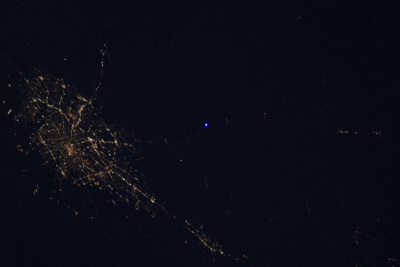
Amateur astronomers flash the space station (another story about it, with animated gif showing the flash)
It would be easy to power a one watt laser from the ISS solar panels :). The ISS is normally only visible at night briefly, as it leaves the sunlit side of the Earth, or just before it returns to it. You see it when it is still lit up by the sun, although the Earth below is already in darkness. For much of its orbit on the dark side of Earth, it is in complete darkness, and invisible from the ground.
So, shine a one watt laser from the ISS down towards New York say or some other big city, when the ISS is in darkness, and they should see a bright blue "star" appear briefly in the sky, brighter than Arcturus, just as the ISS astronomers did the other way around with a one watt laser shining up towards the ISS.
This originated as my answers to: What would happen if, during a spacewalk an astronaut tossed a screwdriver as hard as possible towards Earth? and: Can you de-orbit a tennis ball (or baseball) by hand from the ISS during EVA?
NEW KINDLE BOOK
Want to read more like this, in book format? Try my new kindle book: Simple Questions - Surprising answers - In Astronomy. You can read it online with the kindle cloud reader, or on a kindle device, or use the kindle app on any other device (quick and easy to install).
Everything in the book is also available to read for free online, but it's all gathered together as a book.


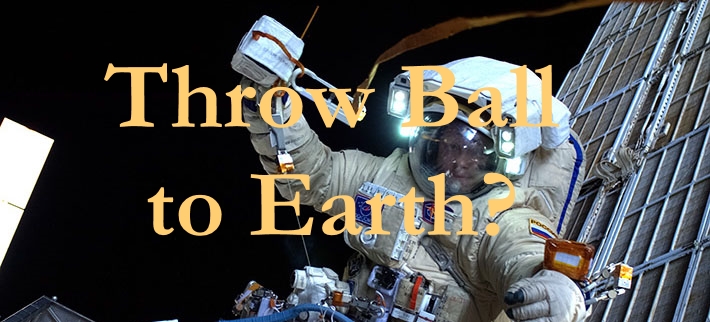
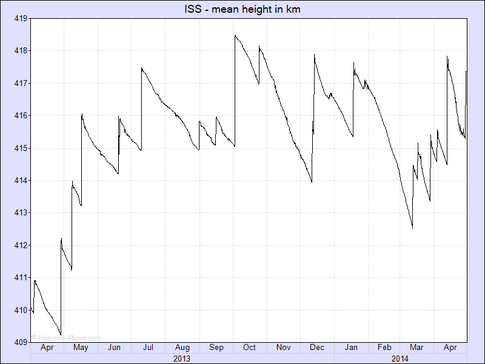
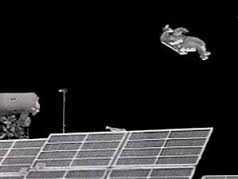
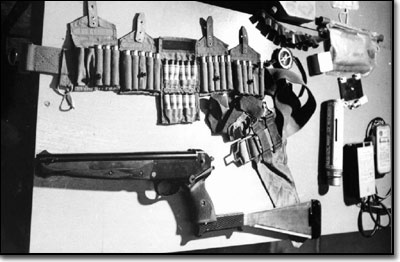



Comments